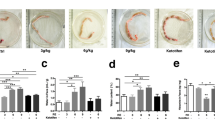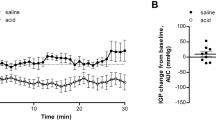Abstract
HISTIDINE and other amino-acids normally undergo deamination in ruminal fluid1, and decarboxylation with the formation of histamine does not normally occur in the rumen to any great extent. When sheep or cattle are fed a diet containing excessive amounts of carbohydrate, however, the histamine content of ruminal fluid may increase considerably and concentrations > 70 µg/ml. have been recorded2. Van der Horst3 has shown that the concentration of amino-acids and amines in ruminal fluid can be increased by incubation with glucose.
This is a preview of subscription content, access via your institution
Access options
Subscribe to this journal
Receive 51 print issues and online access
$199.00 per year
only $3.90 per issue
Buy this article
- Purchase on Springer Link
- Instant access to full article PDF
Prices may be subject to local taxes which are calculated during checkout
Similar content being viewed by others
References
Lewis, D., Brit. J. Nutr., 9, 215 (1955).
Dain, J. A., Neal, A. L., and Dougherty, R. W., J. Anim. Sci., 14, 930 (1955).
Van der Horst, C. J. G., Nature, 191, 73 (1961).
Blaschko, H., Ciba Found. Symp. Histamine, 202 (Churchill, London, 1956).
Broberg, G., Acute Overeating with Cereals in Ruminants (A. B. Lavisa Nya Tryckeri, Lavisa, Finland, 1960).
Author information
Authors and Affiliations
Rights and permissions
About this article
Cite this article
SANFORD, J. Formation of Histamine in Ruminal Fluid. Nature 199, 829–830 (1963). https://doi.org/10.1038/199829a0
Issue Date:
DOI: https://doi.org/10.1038/199829a0
This article is cited by
-
Digestive disturbances in ruminants: An electromyographic study
Veterinary Science Communications (1980)
-
Histamine formation by ruminal fluid from cattle in vitro
Experientia (1977)
-
Fate of Ingested Histamine in Sheep
Acta Veterinaria Scandinavica (1967)
-
Determination and Occurrence of Histamine in Rumen Liquor of Sheep
Acta Veterinaria Scandinavica (1967)
Comments
By submitting a comment you agree to abide by our Terms and Community Guidelines. If you find something abusive or that does not comply with our terms or guidelines please flag it as inappropriate.



